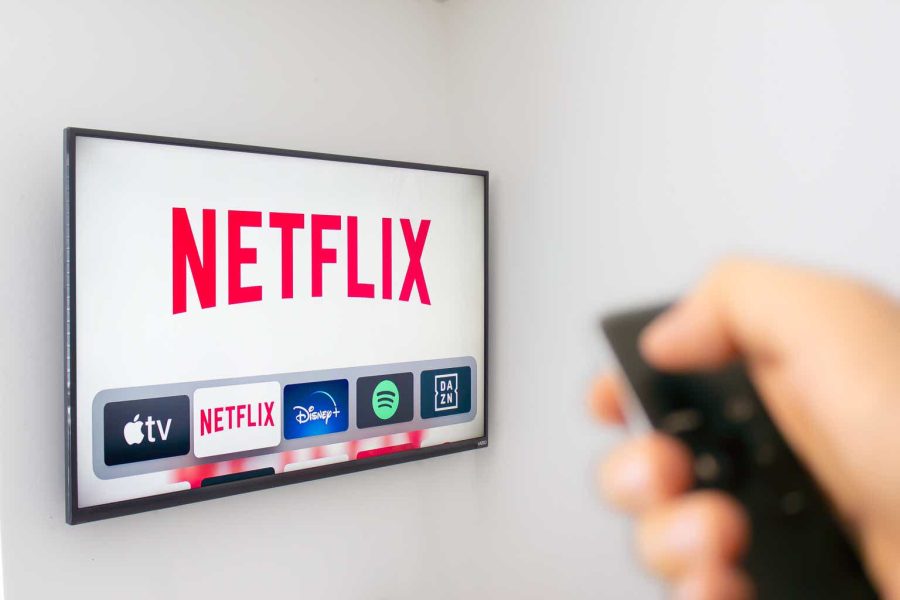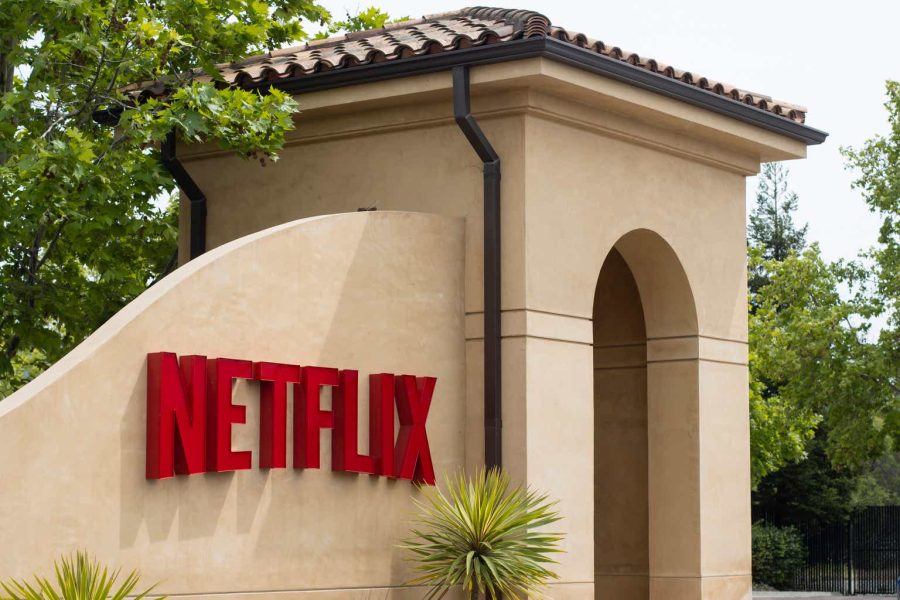July 14, 2024 This Week Top S&P 500 Gainers & Losers
Tesla Q2: The Bottom Is Likely In
Tesla: Time To Take Profits
Microsoft: The Q4 Results Should Surprise You
Tesla: Optimus And FSD Probably Won’t Save The Day
April 23, 2024 Maximizing Profits: When is the Right Time to Sell Your Business?
April 12, 2024 Improve Your Financial Status: A How-To Guide
April 12, 2024 How ZIM Integrated Container Tracking is Revolutionizing Global Trade
March 15, 2024 6 Best Growth Stocks To Buy Now According to Metatrader 5

Netflix (NFLX) Stock Forecast for 2024–2028. Sell or Buy?
Updated: July 27, 2024 (03:31)
Sector: Communication servicesThe share price of Netflix, Inc. (NFLX) now
50/200 Day Moving Average: $653.95 / $554.87
This figure corresponds to the Average Price over the previous 50/200 days. For Netflix stocks, the 50-day moving average is the resistance level today.
For Netflix stocks, the 200-day moving average is the support level today.
Are you interested in Netflix, Inc. stocks and want to buy them, or are they already in your portfolio? If yes, then on this page you will find useful information about the dynamics of the Netflix stock price in 2024, 2025, 2026, 2027, 2028. How much will one Netflix share be worth in 2024 - 2028?
When should I take profit in Netflix stock? When should I record a loss on Netflix stock? What are analysts' forecasts for Netflix stock? What is the future of Netflix stock? We forecast Netflix stock performance using neural networks based on historical data on Netflix stocks. Also, when forecasting, technical analysis tools are used, world geopolitical and news factors are taken into account.
Netflix stock prediction results are shown below and presented in the form of graphs, tables and text information, divided into time intervals. (Next month, 2024, 2025, 2026, 2027 and 2028) The final quotes of the instrument at the close of the previous trading day are a signal to adjust the forecasts for Netflix shares. This happens once a day.
Historical and forecast chart of Netflix stock
The chart below shows the historical price of Netflix stock and a prediction chart for the next month. For convenience, prices are divided by color. Forecast prices include: Optimistic Forecast, Pessimistic Forecast, and Weighted Average Best Forecast. Detailed values for the Netflix stock price can be found in the table below.
Long-term forecasts by years.


When forecasting Netflix (NFLX) stock rates, several crucial factors are expected to significantly influence changes in the near future. Major determinants such as revenue growth, earnings per share (EPS), and market growth are pivotal for shaping NFLX's stock trajectory. Understanding these aspects can help analysts make precise predictions regarding the company's stock price.
Revenue Growth and Market Dynamics
Revenue growth stands out as a primary indicator of Netflix's ability to expand its business and generate income. With projected revenues hitting $52.17 billion by 2027, sustained growth is likely to boost stock appreciation through enhanced profitability and market dominance. The company's earnings per share (EPS) are also pivotal, with expected figures reaching $31.76 by 2027, signifying robust financial health and investor confidence.
The global video streaming market, anticipated to grow at a CAGR of 21.5% from 2024 to 2030, presents a favorable environment for Netflix's expansion. As a market leader with 270 million subscribers and a 16% YoY increase, Netflix is poised to capitalize on this growth, further influencing its stock price positively.
- Revenue Growth
- EPS
- Global Market Growth
Additionally, innovation and technology investments such as advanced recommendation algorithms, 4K HDR production, and content delivery networks bolster Netflix’s competitive edge, ensuring high-quality streaming and subscriber retention. These factors, coupled with effective cost management strategies and an anticipated Fed rate of 2.9% by 2027, provide a comprehensive outlook for analysts to forecast NFLX stock trends accurately.
By monitoring these key areas, analysts can make informed predictions, leveraging insights into the company’s strengths and market position to project future NFLX stock performance confidently.
Review the original Analysis

Netflix's Future Stock Rates: Key Indicators to Watch

Predicting the future of Netflix (NFLX) stock requires a nuanced understanding of several critical factors impacting its valuation. Recent trends and anticipated developments suggest a vibrant outlook for NFLX stock rates, bolstered by various influential elements.
Factors Influencing NFLX Stock Rates
First and foremost, subscriber growth is paramount. The impressive addition of 8.05 million subscribers has already signaled Netflix's robust market position and generated optimism among investors. Analysts should closely monitor subscriber trends as they are a direct indicator of revenue potential and market strength.
Another significant driver is original content. Netflix's commitment to high-quality, unique series and movies, such as the much-anticipated "Squid Game" Season 2 and "The Umbrella Academy" finale, is crucial. These releases not only enhance subscriber retention but also differentiate Netflix from competitors like Disney and Warner Bros. Hence, assessing upcoming content and viewer engagement can guide accurate NFLX stock forecasts.
Revenue and earnings performance also play a crucial role. Despite a minor miss in 3Q24 revenue expectations, Netflix showcased a 16.8% year-over-year revenue increase and a notable EPS beat. This financial resilience highlights the company’s operational efficiency, making earnings reviews essential for future stock predictions. Additionally, upward revisions in full-year revenue guidance bolster growth confidence.
Management guidance and market sentiment are critical too. Consistent outperformance of conservative forecasts illustrates Netflix’s strategic prowess, influencing how investors perceive future growth. Observing management's strategic focus, particularly on engagement metrics linked to original content, can provide deeper insights into potential stock movements.
- Subscriber growth: Key revenue driver and market strength indicator.
- Original content: Enhances retention and differentiates Netflix from competitors.
- Revenue and earnings performance: Shows financial health and operational efficiency.
- Management guidance and market sentiment: Reflects strategic execution and investor confidence.
- Gaming initiative: Promising long-term growth avenue.
Lastly, the gaming initiative, although nascent, is a burgeoning area to watch. With over 100 games launched and more in development, this venture could diversify revenue streams and deepen subscriber engagement, potentially becoming a significant factor in future stock value assessments.
By diligently analyzing these factors, analysts can make more accurate predictions regarding changes in NFLX stock price, aligning their forecasts with actual performance and strategic developments within the company.
Review the original Analysis

Key Factors Shaping the Future of NFLX Stock Prices

Netflix, Inc. (NFLX) faces a complex web of factors that will shape its stock prices in the foreseeable future. Analysts must carefully consider these elements to forecast NFLX stock rates accurately. One paramount factor is competitive market dynamics. With significant players like Disney, Amazon Prime Video, and regional streaming services ramping up their offerings, Netflix is under pressure to invest heavily in content development and marketing, affecting profit margins and subscriber growth.
Ad-Supported Tier and Regulatory Challenges
Another crucial aspect is the mixed performance of Netflix’s ad-supported tier. While uptake has been strong, its contribution to revenue is anticipated to be modest until at least 2026. This lag, along with declining CPMs, could dampen investor expectations. Regulatory challenges in markets like Canada and the Philippines further complicate the landscape, as mandatory content contributions and added taxes elevate operational costs, pressuring profitability.
Analysts must also weigh the investment in live sports, the intricacies of streaming service bundling and partnerships, and Netflix's attempt to internalize its advertising technology. Each of these elements brings both risks and opportunities.
- Competitive Market Dynamics: Intensifying competition pressures Netflix to boost content and marketing spending.
- Ad-Supported Tier Performance: Lag in revenue growth and declining CPMs affect forecasts.
- Regulatory Challenges: Increased operational costs from new regulations.
- Investment in Live Sports: High costs of broadcasting rights versus the potential gains.
- Bundling and Partnerships: Potential for subscriber acquisition but risk of reduced average subscription revenue.
- Internalization of Advertising Technology: Long-term profit improvement versus execution risks.
By meticulously analyzing these factors, a more precise NFLX stock forecast can be achieved. Historical stock trends combined with insights into these evolving dynamics will provide a clearer picture for investors looking to navigate Netflix’s financial future.
Review the original Analysis
Streaming Giant NFLX Poised for Prosperous Year Ahead
Netflix (NFLX) has once again stunned the market with a robust earnings report and strong Q4 results, sending shares climbing by 8.7% in after-hours trading to $534.80. An announcement of increased investments in live programming served as the catalyst for this leap, which builds on the company’s regular session gains. Most notably, the spotlight shines on a partnership with TKO Group (TKO), landing Netflix exclusive rights to blockbuster shows and star-studded board membership.
But how accurately can NFLX stocks be predicted? Given the latest financial metrics, it seems forecasting NFLX stock rates requires careful examination of patterns, investments, and market responses. With their Q4 triumph, featuring the highest global streaming paid memberships on record for a final quarter, NFLX has galvanized investor confidence. Moreover, reaching a milestone of 260.3 million subscribers and a revenue spike of 12.5% to $8.83 billion, outdoing the consensus of $8.71 billion, NFLX showcases its capacity to exceed expectations.
Factors Fueling NFLX’s Stock Trajectory
Several factors this year are set to significantly shape NFLX’s stock fortunes. A landmark $5 billion-plus TKO deal not only strengthens content offerings but also bridges alliances with sports entertainment leaders. The company’s decision to welcome Dwayne “The Rock” Johnson to the board could enhance strategic direction, potentially rallying the stock further.
Quotes from Netflix’s stimulus strategies reflect a calculated push into live events, foreshadowing a diversification that could underpin stock resilience. Additionally, with an increased operating margin of 21% surpassing the target alongside robust cash flows, NFLX is demonstrating financial vigor that could underpin positive NFLX stock forecasts.
In closing, while Netflix stock history illuminates the stock’s volatile nature, recent developments make a persuasive case for bullish nflx stock forecast perspectives. Investors should monitor for fluctuations in the Netflix stock graph, but optimism appears warranted. Yet, even with these promising signs, it’s a reminder that speculation isn’t absolute, and the query ‘is Netflix going out of business’ remains—for now, emphatically muted by current successes.
Netflix, Inc. is an American company that provides movies and TV series based on streaming media. In recent years, Netflix has launched its own production of television series that are only available to its customers, in particular House of Cards.
Netflix daily forecast for a month
| Date | Target | Pes. | Opt. | Vol., % |
|---|---|---|---|---|
| Jul 29 | 640.84 | 634.31 | 647.76 | 2.12 |
| Jul 30 | 638.15 | 633.81 | 644.02 | 1.61 |
| Jul 31 | 643.38 | 640.04 | 649.82 | 1.53 |
| Aug 01 | 639.78 | 629.80 | 644.77 | 2.38 |
| Aug 02 | 637.09 | 628.94 | 644.36 | 2.45 |
| Aug 03 | 639.39 | 636.70 | 647.44 | 1.69 |
| Aug 04 | 645.65 | 635.58 | 648.62 | 2.05 |
| Aug 05 | 645.40 | 637.01 | 649.27 | 1.92 |
| Aug 06 | 654.43 | 644.22 | 660.06 | 2.46 |
| Aug 07 | 660.19 | 650.82 | 663.09 | 1.89 |
| Aug 08 | 659.66 | 655.31 | 666.39 | 1.69 |
| Aug 09 | 664.54 | 656.97 | 672.52 | 2.37 |
| Aug 10 | 665.87 | 661.88 | 671.73 | 1.49 |
| Aug 11 | 679.06 | 676.34 | 684.35 | 1.18 |
| Aug 12 | 690.06 | 685.23 | 694.20 | 1.31 |
| Aug 13 | 684.40 | 676.46 | 687.82 | 1.68 |
| Aug 14 | 688.51 | 684.24 | 691.95 | 1.13 |
| Aug 15 | 694.43 | 691.65 | 697.62 | 0.86 |
| Aug 16 | 694.84 | 689.84 | 705.27 | 2.24 |
| Aug 17 | 680.95 | 670.05 | 684.21 | 2.11 |
| Aug 18 | 686.80 | 683.09 | 695.18 | 1.77 |
| Aug 19 | 685.43 | 681.59 | 696.40 | 2.17 |
| Aug 20 | 680.08 | 669.47 | 686.07 | 2.48 |
| Aug 21 | 683.89 | 675.55 | 691.55 | 2.37 |
| Aug 22 | 697.16 | 692.28 | 702.88 | 1.53 |
| Aug 23 | 692.56 | 685.49 | 703.50 | 2.63 |
| Aug 24 | 683.97 | 681.23 | 694.37 | 1.93 |
| Aug 25 | 674.94 | 671.03 | 684.12 | 1.95 |
| Aug 26 | 675.89 | 672.51 | 678.72 | 0.92 |
| Aug 27 | 668.72 | 662.30 | 672.07 | 1.47 |
Netflix Daily Price Targets
Netflix Stock Forecast 07-29-2024.
Forecast target price for 07-29-2024: $640.84.
Positive dynamics for Netflix shares will prevail with possible volatility of 2.077%.
Pessimistic target level: 634.31
Optimistic target level: 647.76
Netflix Stock Forecast 07-30-2024.
Forecast target price for 07-30-2024: $638.15.
Negative dynamics for Netflix shares will prevail with possible volatility of 1.586%.
Pessimistic target level: 633.81
Optimistic target level: 644.02
Netflix Stock Forecast 07-31-2024.
Forecast target price for 07-31-2024: $643.38.
Positive dynamics for Netflix shares will prevail with possible volatility of 1.505%.
Pessimistic target level: 640.04
Optimistic target level: 649.82
Netflix Stock Forecast 08-01-2024.
Forecast target price for 08-01-2024: $639.78.
Negative dynamics for Netflix shares will prevail with possible volatility of 2.322%.
Pessimistic target level: 629.80
Optimistic target level: 644.77
Netflix Stock Forecast 08-02-2024.
Forecast target price for 08-02-2024: $637.09.
Negative dynamics for Netflix shares will prevail with possible volatility of 2.393%.
Pessimistic target level: 628.94
Optimistic target level: 644.36
Netflix Stock Forecast 08-03-2024.
Forecast target price for 08-03-2024: $639.39.
Positive dynamics for Netflix shares will prevail with possible volatility of 1.659%.
Pessimistic target level: 636.70
Optimistic target level: 647.44
NFLX (NFLX) Monthly Stock Prediction for 2024
| Month | Target | Pes. | Opt. | Vol., % |
|---|---|---|---|---|
| Aug. | 676.19 | 658.87 | 689.71 | 4.47 |
| Sep. | 676.19 | 657.25 | 695.12 | 5.45 |
| Oct. | 656.71 | 618.36 | 681.40 | 9.25 |
| Nov. | 634.65 | 623.48 | 659.02 | 5.39 |
| Dec. | 585.90 | 574.19 | 619.65 | 7.34 |
Netflix forecast for this year
Netflix Stock Prediction for Aug 2024
An uptrend is forecast for this month with an optimal target price of $676.185. Pessimistic: $658.87. Optimistic: $689.71
Netflix Stock Prediction for Sep 2024
An downtrend is forecast for this month with an optimal target price of $676.185. Pessimistic: $657.25. Optimistic: $695.12
Netflix Stock Prediction for Oct 2024
An downtrend is forecast for this month with an optimal target price of $656.71. Pessimistic: $618.36. Optimistic: $681.40
Netflix Stock Prediction for Nov 2024
An downtrend is forecast for this month with an optimal target price of $634.645. Pessimistic: $623.48. Optimistic: $659.02
Netflix Stock Prediction for Dec 2024
An downtrend is forecast for this month with an optimal target price of $585.904. Pessimistic: $574.19. Optimistic: $619.65
Netflix (NFLX) Monthly Stock Prediction for 2025
| Month | Target | Pes. | Opt. | Vol., % |
|---|---|---|---|---|
| Jan | 616.84 | 606.97 | 644.97 | 5.89 |
| Feb | 660.27 | 622.23 | 698.30 | 10.89 |
| Mar | 679.81 | 658.60 | 700.48 | 5.98 |
| Apr | 694.49 | 668.94 | 716.16 | 6.59 |
| May | 683.38 | 670.81 | 714.00 | 6.05 |
| Jun | 710.72 | 677.74 | 724.36 | 6.44 |
| Jul | 722.66 | 708.78 | 759.08 | 6.63 |
| Aug | 764.28 | 719.65 | 788.74 | 8.76 |
| Sep | 746.55 | 722.06 | 759.09 | 4.88 |
| Oct | 741.18 | 700.26 | 754.22 | 7.15 |
| Nov | 796.91 | 782.89 | 845.36 | 7.39 |
| Dec | 835.16 | 789.73 | 860.55 | 8.23 |
Netflix (NFLX) Monthly Stock Prediction for 2026
| Month | Target | Pes. | Opt. | Vol., % |
|---|---|---|---|---|
| Jan | 889.28 | 850.15 | 912.76 | 6.86 |
| Feb | 926.99 | 872.11 | 955.17 | 8.70 |
| Mar | 955.17 | 900.15 | 995.67 | 9.59 |
| Apr | 905.50 | 875.07 | 930.13 | 5.92 |
| May | 928.68 | 892.28 | 949.48 | 6.02 |
| Jun | 961.37 | 915.22 | 1 005.21 | 8.95 |
| Jul | 939.07 | 920.28 | 996.16 | 7.62 |
| Aug | 944.32 | 913.35 | 991.16 | 7.85 |
| Sep | 1 019.11 | 996.29 | 1 068.85 | 6.79 |
| Oct | 1 015.04 | 970.38 | 1 033.72 | 6.13 |
| Nov | 989.05 | 936.04 | 1 025.45 | 8.72 |
| Dec | 1 007.25 | 959.71 | 1 058.82 | 9.36 |
Netflix (NFLX) Monthly Stock Prediction for 2027
| Month | Target | Pes. | Opt. | Vol., % |
|---|---|---|---|---|
| Jan | 1 026.59 | 965.82 | 1 089.01 | 11.31 |
| Feb | 1 010.99 | 994.00 | 1 073.26 | 7.38 |
| Mar | 1 087.01 | 1 032.23 | 1 149.63 | 10.21 |
| Apr | 1 079.19 | 1 010.12 | 1 124.08 | 10.14 |
| May | 1 126.67 | 1 061.77 | 1 189.76 | 10.76 |
| Jun | 1 095.12 | 1 025.91 | 1 165.21 | 11.95 |
| Jul | 1 116.15 | 1 091.15 | 1 187.58 | 8.12 |
| Aug | 1 174.19 | 1 103.74 | 1 200.49 | 8.06 |
| Sep | 1 174.19 | 1 101.86 | 1 196.73 | 7.93 |
| Oct | 1 232.43 | 1 210.74 | 1 254.12 | 3.46 |
| Nov | 1 136.79 | 1 113.15 | 1 209.55 | 7.97 |
| Dec | 1 137.70 | 1 105.85 | 1 164.10 | 5.00 |
Netflix (NFLX) Monthly Stock Prediction for 2028
| Month | Target | Pes. | Opt. | Vol., % |
|---|---|---|---|---|
| Jan | 1 163.19 | 1 101.77 | 1 205.06 | 8.57 |
| Feb | 1 162.26 | 1 125.99 | 1 196.66 | 5.91 |
| Mar | 1 207.82 | 1 143.08 | 1 252.27 | 8.72 |
| Apr | 1 192.36 | 1 159.93 | 1 259.13 | 7.88 |
| May | 1 215.25 | 1 192.89 | 1 279.42 | 6.76 |
| Jun | 1 189.00 | 1 157.61 | 1 221.34 | 5.22 |
| Jul | 1 215.64 | 1 148.53 | 1 238.98 | 7.30 |
| Aug | 1 214.66 | 1 160.25 | 1 280.74 | 9.41 |
| Sep | 1 258.39 | 1 203.02 | 1 323.83 | 9.13 |
| Oct | 1 242.28 | 1 194.58 | 1 315.83 | 9.21 |
| Nov | 1 228.37 | 1 166.46 | 1 272.59 | 8.34 |
| Dec | 1 250.97 | 1 200.93 | 1 331.03 | 9.77 |
Netflix information and performance
100 WINCHESTER CIRCLE, ., LOS GATOS, CA, US
Market capitalization of the Netflix, Inc. is the total market value of all issued shares of a company. It is calculated by the formula multiplying the number of NFLX shares in the company outstanding by the market price of one share.
EBITDA of Netflix is earnings before interest, income tax and depreciation of assets.
P/E ratio (price to earnings) - shows the ratio between the price of a share and the company's profit
Price/earnings to growth
Dividend Per Share is a financial indicator equal to the ratio of the company's net profit available for distribution to the annual average of ordinary shares.
Dividend yield is a ratio that shows how much a company pays in dividends each year at the stock price.
EPS shows how much of the net profit is accounted for by the common share.
Trailing P/E depends on what has already been done. It uses the current share price and divides it by the total earnings per share for the last 12 months.
Forward P/E uses projections of future earnings instead of final numbers.
Enterprise Value (EV) /Revenue
The EV / EBITDA ratio shows the ratio of the cost (EV) to its profit before tax, interest and amortization (EBITDA).
Number of issued ordinary shares
Number of freely tradable shares
Shares Short Prior Month - the number of shares in short positions in the last month.















































